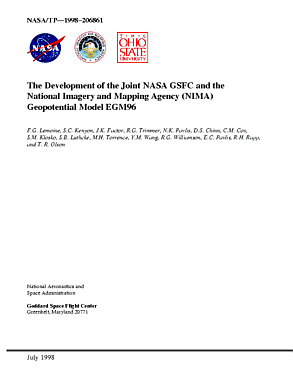



The final version of our Tokyo proceedings paper is now available. The paper has been published by Springer-Verlag, and the full reference is as follows:
The Development of the NASA GSFC and NIMA Joint Geopotential Model,
F. G. Lemoine, D. E. Smith, L. Kunz, R. Smith, E. C. Pavlis, N. K. Pavlis,
S. M. Klosko, D. S. Chinn, M. H. Torrence, R. G. Williamson, C. M. Cox, K. E.
Rachlin, Y. M Wang, S. C. Kenyon, R. Salman, R. Trimmer, R. H. Rapp, and R. S.
Nerem,
IN: Gravity, Geoid and Marine Geodesy, Vol. 117, International
Association of Geodesy Symposia, J. Segawa, H. Fujimoto, and S. Okubo (editors),
pp 461-469, 1997.
 Click here to download a postscript version of the Tokyo paper, 66.4 kbytes.
Click here to download a postscript version of the Tokyo paper, 66.4 kbytes.

Some of you have asked about the EGM96 tidal solution. The low-degree (to degree 70) portion of the solution also included an adjustment for 12,000 parameters, including the geopotential coefficients to degree 70, 112 tidal coefficients, pole position from 1980 to 1994, station coordinates, and coefficients of the dynamic ocean topography (DOT) for TOPEX/ERS-1 and GEOSAT to degree and order 20.
 Click here to view a synopsis of the tidal solution, extracted
from the EGM96 Technical Report.
Click here to view a synopsis of the tidal solution, extracted
from the EGM96 Technical Report.

 Click here to go to the NGA web page on EGM96, and retrieve
the geoid grid.
Click here to go to the NGA web page on EGM96, and retrieve
the geoid grid.
Please see Rapp [1996], for a discussion of the height anomaly/geoid undulation difference.
 back to EGM96 home page
back to EGM96 home page

Last updated June 17, 2005 18:13 UTC.